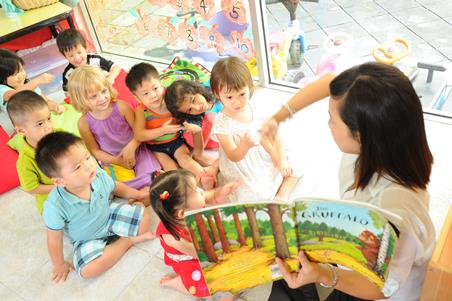A World of Difference

"Children who learn to respect and appreciate racial and cultural diversity are likely to form more positive relationships with others and better manage and express their emotions," say Ms Jacquelinn Wong and Ms Ng Siew Chin, Research Assistants working on the Singapore Kindergarten Impact Project at the National Institute of Education.
.jpg?sfvrsn=ed6ed356_0)
Here are some tips for parents on how to use multicultural picture books to promote pre-schoolers' socio-emotional development!
SPOT A MULTICULTURAL PICTURE BOOK
A multicultural picture book is one that provides a voice for the minority. More often than not, however, we find books that present stereotypical images, such as frail elderly persons, fathers working as working professionals and mothers as housewives, characters from a dominent race/ culture.
.jpg?sfvrsn=6ab8b4f1_0)
When choosing a book to read to children, Ms Wong and Ms Ng suggest that parents be discerning and look carefully at how people, facts and events are presented or represented:
- Characters, plots and images should not be discriminatory in any way;
- Messages should convey positive values;
- Storyline should evoke feelings of familiarity for children, and leave room for discussion and exploration.
.jpg?sfvrsn=b503cd74_0)
HOW TO USE MULTICULTURALISM TO PROMOTE A CHILD'S SOCIO-EMOTIONAL DEVELOPMENT
"A child, who is given positive opportunities to be exposed to racial and cultural diversity, is in a position to relate to and interact appropriately with others. He or she would have a better sense of self, positive self-esteem and identity - recognising that he or she need not competye with 'the others' regardless of what they have or do not have," says Ms Wong and Ms Ng.
It is thus important that adults portray the right attitude towards diversity, looking beyond common stereotypes relating to race, culture, gender, age and abilities, so children can model their behaviour and imbue good values. "We need to help our children recognise that as much as we are different in customs and traditions, we are actually the same - humans with emotions, needs and rights," says Ms Wong.
.jpg?sfvrsn=7eedc46c_0)
Understanding what "other people" go through helps children to understand and learn to regulate their own emotions and how they related with their peers and others. Besides using tools such as multicultural picture books, Ms Wong and Ms Ng suggest the following tips:
- Objectively address children's curiosities and/or stereotypical assumptions relating to race, culture, gender, age or abilities;
- Provide children with books/materials/toys that depict a variation of gender roles (e.g. male nurses, female fire-fighters), racial/ cultural traditions, and people and practices from different parts of the world;
- Actively engage in communal activities to create opportunities for children to share and interact with people and customs outside of your own race/ culture; and
- Provide opportunities for children to be exposed to music, performances and experiences from different cultures.
For recommended book titles, keep a look out for the Oct - Dec 15 issue of Beanstalk magazine!
You may also like

From Cabin to Classroom: Journey of an Outstanding Early Childhood Educator
The PDP modules allowed me to get creative with lesson ideas and keep up with the ever-changing Early Childhood sector.

Ms Farhana Binte Mohamed Hassan
Early Years Educator - PCF Sparkletots @ Pioneer Block 987D (CC)

More Than Just a Place for Food
Young children are highly inquisitive, and learn most effectively with activities that allow exploration and experimentation.

Kinderland @ Yio Chu Kang

Little Fingers Create Great Art - A Community Project by Kinderland and Skool4kidz
I believe this collaborative effort is a very meaningful contribution to the SG50 celebrations.

Kinderland and Skool4Kidz